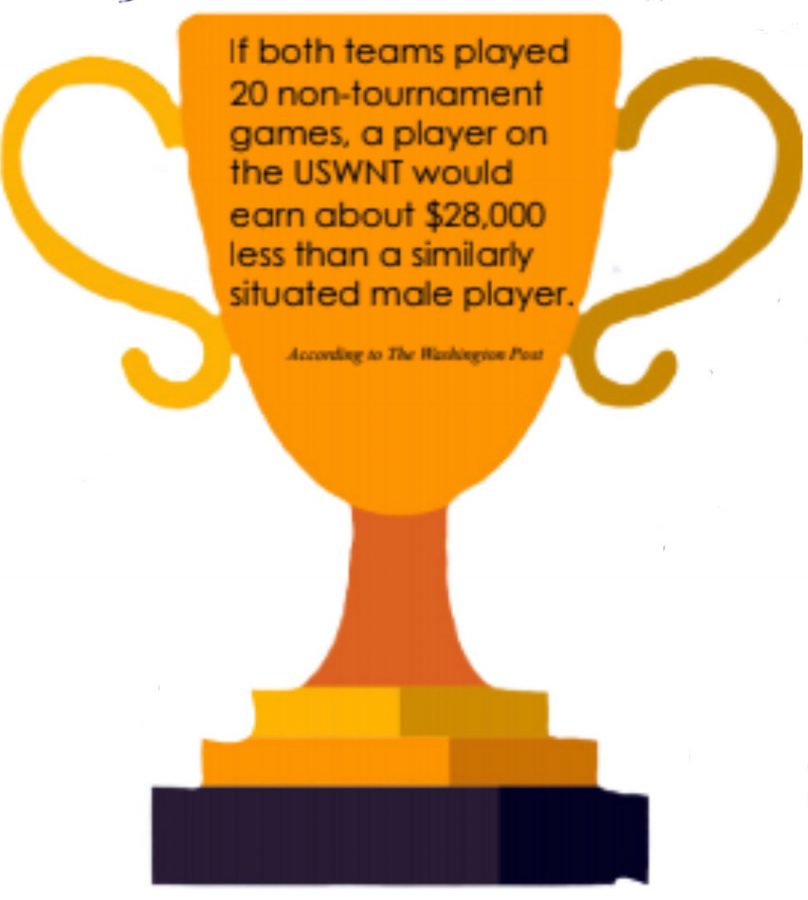Progress of women’s sports leads to brighter future for female athletes
August 21, 2019
Over 15 million viewers in the U.S. held their breath as Meghan Rapinoe took a penalty shot on the Dutch goalie, scoring the first goal in the 2019 FIFA Women’s World Cup. With another goal from Rose Lavelle, the game ended with a score of 2-0, and the U.S. Women’s National Team (USWNT) won their fourth World Cup championship.
“To me [the win] means so much recognition for all the things that females can do that so many people don’t give them recognition for,” ETHS senior and soccer player Abra Levin says. “It’s beyond inspiring for so many athletes and women in general.”
The USWNT home jersey is the best selling soccer jersey ever sold on Nike in one season, men’s or women’s, and in the past 11 years, FIFA has ranked the team No.1 ten times. There’s no question the team is doing an incredible job, but this is not being conveyed through their pay and treatment.
Four months before the World Cup, every member of the current USWNT filed a class-action lawsuit against the U.S. Soccer Federation (USSF), claiming gender discrimanation in treatment and pay, a violation of the Equal Pay Act and Title VII of the Civil Rights Act, according to the Washington Post.
“I think [the lawsuit] is really awesome, and it’s challenging but it’s bringing a ton of awareness to the issue,” Levin says. “I think it’s proving to other girls, even outside of soccer, that they don’t have to sit and watch while they’re being discriminated against, they can do something about it.”
The team included in the lawsuit that in 2017, the USSF provided at least 17 flights for the men’s team but none for the women. Also, between 2014 and 2017, the men’s team played all their domestic games on grass but one, while the women’s team played more domestic games than the men, but 13 of them were on less safe artificial surfaces. Although they are performing similar jobs under the same employer, the USWNT is not being treated or paid as well as the men’s team, even when they outperform them.
Since the USWNT has a base salary and earns bonuses, and the male players are paid only in bonuses, it is extremely difficult to directly compare the earnings of players. Also, bonuses are determined by the outcome of the game and ranking of the other team, and the teams don’t play the same number of games. There have been times when USWNT players have been paid more than male players, but they have played and won more games.
According to the Washington Post Fact Checker, if both teams played 20 non-tournament games, a player on the USWNT would earn about 89% of the pay a similarly situated male player would earn, a difference of over $28,000. If both teams lost those 20 games, the players would earn the same amount because a male player earns a $5,000 bonus when they lose and a female player has a $100,000 base salary, but doesn’t earn a bonus.
About half the revenue from the USSF comes from sponsorships, and about a fourth comes from games from both national teams. Sponsorships are sold as a package for both teams so it is difficult to compare which team brought in more. Since the USWNT won the 2015 World Cup, both teams have brought in about the same amount of revenue from games, despite the fact that in the lawsuit, the team included that less promotion of the women’s games and lower ticket prices.
In the 2019 Women’s World Cup, the total prize money was $38 million, and each player was compensated $4 million. In the 2018 Men’s World Cup, the total prize money was about $400 million, and the male players were compensated $38 million each. This can be attributed to less money in the women’s game altogether, even though the women’s team has outperformed the men’s team on the world stage and has substantially contributed to the USSF revenue. On June 24, the Wall Street Journal reported that the USSF and the USWNT have agreed to mediation.
Although the U.S is only beginning to address the issue of the inequality between men and women’s soccer pay, many other countries have tackled this problem already. The Nigerian soccer team held a sit-in protest at a hotel in 2016 in reaction to the women’s lack of payment after the Africa Cup of Nations. In 2018, New Zealand’s women’s national team demanded a deal in which the men and women’s teams would be paid equally. In Norway 2017 men and women teams representing their country received equal pay.
Players in the U.S such as Megan Rapinoe have spoken out about the womens sports pay gap. Rapinoe tweeted out after speaking on Good Morning America with other members of the WNT, “I think the conversation needs to move from are we worth it, should we have equal pay to what can we do now.”
“I think they have an amazing platform for representing all of women’s soccer,” sophomore and center mid for Northwestern women’s soccer team Chloe McGhee says. “Finally having a fight for equal treatment and equal pay is really important and I think they’re utilizing that, especially after this world cup.”
The fight for equity in women’s sports does not stop at pay, though. In a New York Times Op-Ed video, track Olympian and national champion Alysia Montaño confronted Nike on their lack of maternity and pregnancy protections for female athletes after she was told that her contract would be paused during her pregnancy.
“The sports industry allows for men to have a full career. And when a women decide to have a baby, it pushes women out at their prime,” Montaño said. “I was very upset that there was not a policy in place to protect me.”
Not only was Montaño told that Nike would stop paying her, but when she was recovering from her pregnancy and switched to being sponsored by ASICS, they also threatened to end her pay. Aside from sponsors, the U.S. Olympic committee terminates athletes health insurance if they “do not stay at the top of our game during pregnancy,” according to Montaño.
“Women have been forced and felt pressure to have babies and made to feel that it is there job for so long,” Levin said. “Now that they’re saying ‘if you do the job we put in place for you throughout history we are gonna drop you from your job’ and It’s societies fault.”
During maternity, athletes can still make marketing appearances for their sponsors, and they can also continue to stay active in their sport, but trying to maintain or reinstate their previous level of intensity in a short amount of time can be dangerous.
Six months after giving birth to her first child, Montaño won a national championship, and within ten months had won another. While competing in the world championships in Beijing, she pumped and shipped milk back to the U.S. for her daughter. In order to do this though, Montaño had to tape her abs together which had been torn apart during pregnancy and wear a brace when she lifted “to come back within [the sponsors] time frame.”
Ten days after Montaño’s video was released, nine time Olympic track and field medalist Allyson Felix released her own pregnancy story through The New York Times, accusing sponsors of the same lack of protections as Montaño had.
“While I’m spending countless hours in the NICU, I’m coming home at one a.m. trying to figure out how can I get to the gym to put a few hours because I know I have to be ready to run in six months,” Felix said. “Many times I just felt like I was in an impossible situation.”
As of May 22, 2019, Felix had been without a contract for almost a year and a half because no contract she was being offered included maternity protections.
“I was already offered 70% less of what I had been played before. I can take less money, but the one point I wasn’t willing to budge around was maternity,” Felix said. “I’ve been one of Nike’s most widely marketed athletes. If I can’t secure maternity protections, who can?”
Other athletes have spoken out against Nike’s policies, although confidentiality clauses implemented by sponsors have prohibited athletes from doing so. Professional runner Phoebe Wright told The New York Times “Getting pregnant is the kiss of death for a female athlete,” and that she would not tell Nike if she were pregnant. Olympic runner Kara Groucher also told them that she had to choose between running a half marathon three months after she had given birth in order to reestablish her pay or stay with her sick newborn in the hospital.
On May 24, 2019, Nike addressed the accusations, finally promising to eliminate performance pay reductions, for athletes who decide to have a baby, for 12 months.
The issue Nike had with maternity protections though seems uncharacteristic for the brand they’ve created. Last February, Nike released their “Dream Crazier” ad campaign as a follow up to “Dream Crazy,” which had previously been released in September of 2018.
The advertisement focuses on issues female athletes face, recent accomplishments the athletes have received, and included lines such as “If we show emotion, we’re called dramatic. If we dream of equal opportunity, delusional. And if we get angry, we’re hysterical, irrational, or just being crazy.” It also shows videos from events when these statements have been real feelings for female athletes
After “Dream Crazy” went viral on social media, Nike released three more advertisements, “Dream With Us”, “Dream Further”, and “Never Stop Winning”, all focusing on the dreams and aspirations of young women in sports and the achievements of female athletes.
“Never Stop Winning” aired only once, immediately after the U.S. Women’s National Team won the World Cup. The ad focused completely on the team, and included lines such as, “I believe that we will make our voices heard, and TV shows will be talking about is every single day and not just once every four years, and that women will conquer more than just the soccer field, like breaking every single glass ceiling.”
McGhee was moved by the advertisement and thinks the ad campaign is inspiring for female athletes.
“[The commercial’s] right, it’s not crazy, just do what you want to do, and that’s what you should be living by,” she says. “It’s definitely left a footprint on not just soccer players, but even people that play other sports.”




















